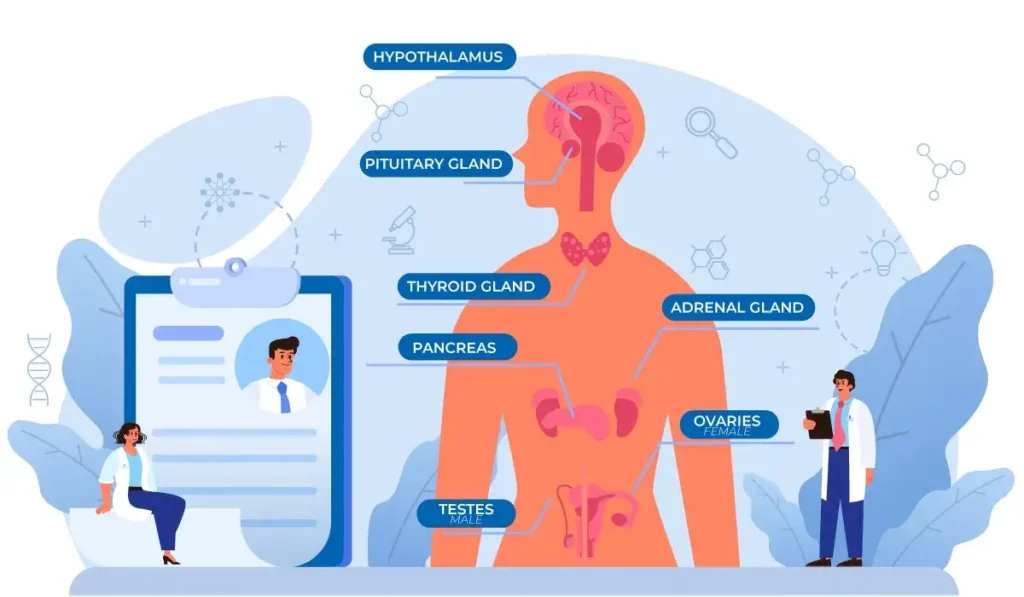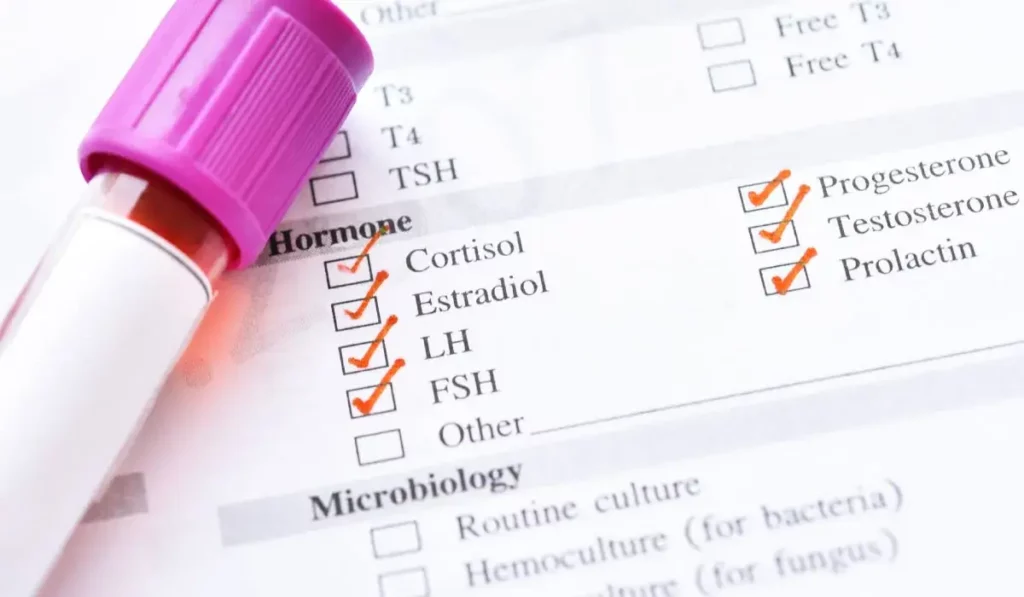When someone talks about hormones, most people will automatically think about hormonal contraceptives, sex hormones, or thyroid hormones, but that is only the tip of the iceberg. Here is everything you need to know about hormones and their actual role in your body.
What are hormones and how do they function?
The term hormone encompasses an array of chemical substances that act as messengers, travelling through the bloodstream to different parts of the body, affecting the activity of cells in tissues and organs. They play a crucial role in controlling and coordinating a wide range of activities in the body, including growth and development, reproduction, and the digestion and absorption of nutrients, and how they are used.
But how do these “messengers” work? Once the hormone is released into the bloodstream, it travels throughout the body. Different types of hormones will travel to and act on different tissues and organs. Some only affect specific areas, and others affect the whole body. When a hormone reaches its target, it attaches itself to specific receptors, transmitting a “message” to those cells, resulting in a response and action from the target tissue or organ.
These receptors are what allows a hormone to act, meaning that if an organ doesn’t have receptors for that hormone, or the receptors don’t work properly, it won’t be able to transmit its message. An example of this is Type 2 Diabetes, where insulin signaling is impaired because its receptor does not transmit the message properly to the cells.
With hormones, a little bit goes a long way, meaning that small changes in hormone levels can have a significant impact on your body, and even lead to certain conditions that might require medical treatment. Because of this, the human body has a very intricate and controlled system that produces hormones, and continuously monitors and regulates their levels: the endocrine system.
The endocrine system
The endocrine system consists of a group of glands and organs that produce and secrete hormones either directly into the bloodstream (endocrine glands), or into a duct or tube (exocrine glands). Some hormonal glands, like the pancreas, have different types of cells, which allow them to act as both endocrine and exocrine glands.
The major glands that make up the endocrine system are the hypothalamus, pituitary gland, thyroid gland, parathyroid gland, islet cells of the pancreas, adrenal glands, and gonads (testes in men, and ovaries in women). Each of these glands produces one or more specific hormones, and together, they regulate and control most body functions, and maintain hormone balance.
It is important to remember, however, that not all organs that produce hormones or hormone-like substances are part of the endocrine system, and that not all glands produce hormones or are part of the endocrine system.

Types of hormones
There are many different types of hormones, each with its own target organs, and effects. However, many hormones interact with the same tissues, and even with each other as part of their normal function. Let’s look at some of the more well-known hormones of the human body.
Thyroid hormones
They are produced by the thyroid gland, in the neck, and regulate the body’s metabolism. The thyroid gland produces two different hormones: T3 and T4. These hormones play an essential role in vital functions such as heart rate, calorie burning, skin maintenance, and growth. Their production and balance are regulated through the release of TSH, produced by the pituitary gland.
Parathyroid hormones
The parathyroid glands are four small endocrine glands usually located in the neck, attached to the thyroid. Their main function is to secrete parathyroid hormones. This hormone facilitates the absorption of calcium in the intestine and its use in bone mineralization. It also stimulates the conversion of vitamin D into its active form, contributing to the regulation of bone growth and remodeling.
Adrenal hormones
These are produced by the adrenal glands located above each kidney and include cortisol (regulates metabolism and stress response), aldosterone (controls sodium and potassium balance in the body), adrenaline and noradrenaline (prepare the body for dangerous situations). These hormones are key factors in the human stress response and regulation of metabolism.
Sex hormones
- Androgens: produced mainly in the testicles in men and in the ovaries in women. The adrenal glands also generate small amounts of androgens in both sexes, which are transformed into other sex hormones according to the body’s needs. The most commonly known androgen is testosterone. In men, androgens are essential for the development and maintenance of male sexual characteristics, such as facial and body hair growth, deeper voice, muscle development and sperm production. In women, androgens also play a role in reproductive health, maintenance of bone mass and libido.
- Estrogens and progesterone: Estrogens and progesterone are female reproductive hormones generated mainly in the ovaries (during pregnancy, the placenta also begins to produce progesterone). There are different types of estrogens, and estradiol is the most important one, as it influences the development of female organs, such as breasts and uterus, as well as physical changes such as pelvic widening, hair growth and the initiation of the menstrual cycle. On the other hand, progesterone increases during the second half of the menstrual cycle, which prepares the uterus for implantation of the fertilized egg and plays a key role during pregnancy.
Pancreatic hormones
The pancreas produces hormones to regulate blood sugar levels. It produces two key hormones: insulin, which lowers blood sugar levels after eating, and glucagon, which raises blood sugar levels between meals. These hormones maintain a balance to ensure an adequate supply of energy to the cells and prevent high glucose levels.

Hormone balance
The body employs various mechanisms to maintain hormone levels balanced correctly, but this does not mean that hormones should always be at the same level, but rather adapt to the different changes and situations the body experiences (throughout the day and over time). For example, the amount of energy needed during sleep is lower than during exercise, so the endocrine system alters different hormone levels to adapt to each situation. It is a dynamic and precise process that avoids too much or too little hormone production and secretion.
How our bodies regulate hormonal levels?
One of the main systems that regulates the secretion of certain hormones is the hypothalamic-pituitary axis, which involves the exchange of hormonal signals between the hypothalamus and the pituitary gland in the brain. The hypothalamus controls the pituitary gland by secreting many hormones, each of which carries a message to the pituitary gland, telling it to produce more or less of some of its hormones. The pituitary gland is sometimes called the master gland because it controls many other endocrine glands, including the thyroid gland, the adrenal glands, and the ovaries and testes.
To better explain how the hypothalamic-pituitary axis works, we will look at how the thyroid hormones are regulated, but this can be applied to most of the hormones controlled by this axis:
- The hypothalamus produces its hormone, which tells the pituitary gland to produce its hormone.
- The pituitary hormone travels through the bloodstream to the thyroid gland, activating it, resulting in the secretion of thyroid hormones.
- This continues to happen until the thyroid hormones are at the right level, at which point, the hypothalamus and pituitary gland are alerted, and they stop secreting their hormones. When the thyroid gland stops receiving a signal from the pituitary gland, it stops secreting its hormones.
Some endocrine functions are not controlled by the hypothalamic-pituitary axis, such as the secretion of parathyroid hormone by the parathyroid glands. In this case, the parathyroid hormone is produced and secreted in response mainly to calcium levels in the blood.
Aside from the control systems implemented by the body, external factors such as injuries, stress, light, and temperature can affect hormone release. Some hormones follow a person’s circadian rhythm or body clock. For example, melatonin, which regulates sleep, has a peak in production during the night, and very low levels during the day. Certain nutrients and minerals are needed to be able to produce certain hormones, so the amount of these nutrients and minerals in the body can also influence how much hormone can be produced.
Hormone treatments
When hormone levels are imbalanced, meaning there is a lack or excess of specific hormones, it results in an endocrine disorder. The first step to treat it is understanding where the issue stems from. Is there a problem with the endocrine gland itself or with the hypothalamic-pituitary axis? Or is it due to a deficiency in nutrients or minerals needed to produce a hormone? Once the source is identified, the next question to answer is: why is it happening?
When an endocrine disorder is suspected, doctors usually do hormone tests to check for imbalances in hormone levels through blood work or urine samples. For more accurate insights, it can be useful to measure hormone levels under specific situations: certain times of the day, right after the person receives something that stimulates or blocks hormone secretion, or after fasting. This sort of hormone testing is helpful to locate where and what the issue is. It allows to monitor and evaluate the correct functioning of hormones under controlled situations.
Endocrine disorders can usually be treated by either replacing the hormone that is missing, or lowering a hormone’s level when it is too high by suppressing its production. Hormone Replacement Therapy (HRT) is commonly used in women to alleviate symptoms of menopause, where the ovaries produce much less estrogen than they used to.
Hormone Research

Research regarding the endocrine system has allowed the scientific and medical community to discover and develop many useful things, and the use of insulin to treat Type 1 Diabetes is probably one of the most fascinating examples.
In the 19th century, researchers found that they could cause diabetes in animals by removing their pancreas, and that this organ produced secretions. This led to many attempts to treat diabetes by using animal pancreatic extracts, with no success, until Federic Banting developed a working pancreatic extract from animals, and with it was able to achieve the long survival of two diabetic dogs.
It is no surprise that this line of investigation was of interest to many researchers, as before the discovery of insulin in 1921, diabetes mellitus (DM) was considered a death sentence, where people with type 1 diabetes would only live for a year or two.
The first time the extract was used in humans, it was given to a 14-year-old boy who was on the brink of death. The boy survived the complications of DM, but the repeated use of the extract caused inflammation, limiting the number of injections the boy could safely receive.
The discovery of insulin was a huge milestone in the management of DM, but collecting it was difficult and the impurities in the extract caused side effects such as inflammation. Methods of cleaning the pancreatic extract were complicated and had to be developed.
Since its discovery, treatment with insulin has evolved, and is a fantastic example of why drug development is so important, and a never-ending process. Initially, insulin was extracted from animal pancreases, through a complex process, making it expensive, and only acted for a short amount of time, meaning that patients would have to receive multiple insulin injections throughout the day. In 1950, an intermediate-acting insulin, which acted for at least 24 hours, was manufactured, and marketed. However, because of its animal origin, patients could develop hypersensitivity to the drug. Since then, there have been many more milestones in the development of insulin, which have improved the treatment of DM, and provided different treatment options to patients worldwide.
Despite all the medical advances in this field, there is still so much more we could learn about how the endocrine system works, and further our understanding of how and why endocrine disorders develop. This knowledge along with medical research is the foundation upon which we can develop treatments and cures for these disorders.
